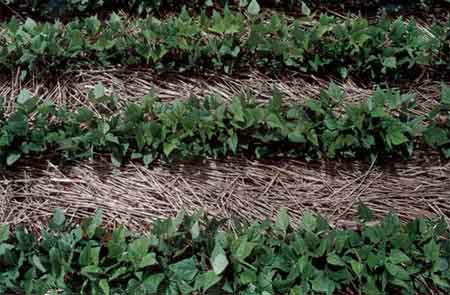5. What wider environmental outcomes have been achieved with successful implementation of Agenda 21? |
|
SUMMARY |
|
Ten cases have been selected to show the wider environmental outcomes that can arise from the successful implementation of SARD. |

This project involves conservation of biological diversity through the maintenance and enhancement of habitats within shade-coffee plantations in a biological corridor linking two protected areas; enhancement of income for farmers producing bio-diversity friendly coffee; and the creation of a bio-diversity friendly coffee export industry.
The project seeks to conserve critical bio-diversity in El Salvador through the maintenance and enhancement of habitats within shade-code plantations in the biological corridor linking El Impossible and Los Volcanes protected areas. The Corridor would cover roughly 75 000 ha, and has been identified as one of the most important national corridors in terms of biodiversity, as well as a strategic link in the regional Mesoamerican Biological Corridor. El Salvador is a country where severe environmental degradation has taken place. Only two percent of the original forest cover remains under natural conditions, and many remaining lands are degraded or eroded because of unsustainable land use practices. Therefore, the establishment of additional protected areas is not a viable alternative for conserving biodiversity over large areas. Restoring degraded land and enhancing productive landscapes for biodiversity conservation are therefore necessary steps for achieving biodiversity conservation. Project outcomes include: a) increase of the areas cultivated under shade coffee using biodiversity friendly practices from the current baseline; b) initiate the establishment of a biological corridor of shade coffee habitats linking protected areas; and c) creation of incentives for biodiversity friendly coffee export industry in El Salvador.
® Source: IPGRI
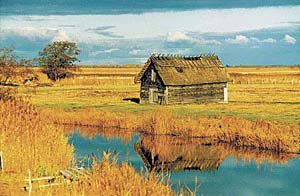
This project involves the reestablishment of the mowing of traditional semi-natural hay meadows, stopping the decline in grazing intensity of traditional coastal pastures, and involves some 100 households on 4 000 hectares. The Matsalu Wetland of International Importance is situated in Western Estonia. Most of its habitats have been affected by human action - including mowing, grazing, etc. as well as forest clearing and reed harvest. Semi-natural communities are among chief values of the wetland. Measures to counteract abandonment of the meadows are therefore given high priority in the Management Plan for Matsalu Wetland. These include mainly grazing or mowing contracts with the farmers and paying compensations according to these. Management has now been carried out for three years according to the Plan. Additional measures not included in the actions proposed in the Plan but contributing to its goals have been investments in machinery available to farmers. Negative trends have been slowed down but more work remains to be done. The most outstanding results are that the mowed area has been restored to 2 000 hectares, the decline in grazing intensity has stopped, the technical capacity to use the meadows has been enhanced, and there is now mutual understanding between nature conservation authorities and the farmers.
® Source: Pretty (1998). The Living Land
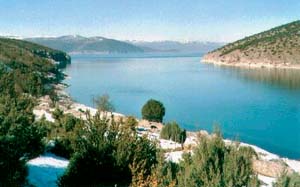
The Prespa National Park is close to the borders of Albania and Macedonia. It comprises a montane valley with two lakes and their surrounding floodplain. It is the home to the largest nesting colony of Dalmatian Pelicans (Pelecanus crispus) in the world. The area is remote, with the main economic activity being farming of beans, with some livestock and fishing to supplement incomes. The traditional land management system has been important for natural capital, as livestock graze the wet meadows and keep down the reeds, so creating valuable habitats for birds and fish. But adoption of intensive cultivation methods for the beans led to the conversion of some meadows to arable, and a big increase in fertilizer and pesticide use. Both of these have had a significant impact on the aquatic resources, and the consequent loss of spoonbills and glossy ibis. In 1993, various organizations began to promote organic bean cultivation, the diversification of agriculture, and the development of the wildlife tourism potential of the park.
Farmers are now getting higher bean yields, as well as premium prices. This is encouraging more to adopt sustainable practices. With the focus on ecotourism, the number of visitors to the park has increased from 5 300 to 13 000. These visitors are better spread throughout the year. Young people from the communities have been trained in environmental management, and two tourism centres have been opened. These have helped to change local attitudes to conservation as well as those of visitors. The growth in ecotourism has prompted the establishment of two guest houses run by local women and several restaurants and tavernas have benefited from increased spending by visitors. Some 50-60 people are now employed in the ecotourism sector. The government has also helped by investing in infrastructure for ecotourism and Multifunctional agriculture.
® Source: Pretty (1998). The Living Land
The dehesas are highly integrated systems contributing significantly to both natural and social capital. The term dehesa refers to a mix of woodland pastures and open grassland, dominated by holm and cork oak, with cereal crops and livestock - sheep, cattle, pigs and goats - feeding on grass and acorns. These are highly integrated systems, with the trees providing charcoal, firewood, shade, acorns and cork; the cereals providing grain and fodder; and the animals providing livestock products (meat and milk). There are usually 4-20 year rotations for arable practices, so the whole landscape is a mosaic of mixed habitats.
They are very rich with wildlife: up to 60 plant species per square metre, butterflies, birds and animals, including threatened species such as Spanish Imperial Eagle, Egyptian Vulture, Black Stork and Iberian Lynx. Dehesas are also important sources of employment for local people when managed properly. For example, one 7 000 ha estate in Andaluca produces cork, timber, firewood, livestock (sheep, deer and cattle) and wild plants (herbs and fungi). The arable and grassland systems are low-input, and there is high labour use. This is higher than neighbouring estates not managed in an integrated fashion. But many of these areas are now in decline, with trees removed for more intensive and large-scale agriculture or land given over to reafforestation with pines and eucalyptus.
Much the same is true of biodiverse habitats in Scotland. Long-term research on the island of Islay in the Inner Hebrides has revealed again the crucial role of a complex and diverse landscape for bird life. Islay has nine important bird species: barnacle goose, chough, corncrake, golden eagle, golden plover, hen harrier, merlin, peregrine falcon and white-footed goose. By dividing the islands semi-natural and agricultural systems into eight types, and classifying all 687 one kilometre squares, it was found that different species use different land types at different times of the year. It was the mosaic that was crucial: "one of the most important features [is] ... how all of the land types are selected at some time in the year. Consequently we concluded that it is the diversity of land types that supports such a large number of bird species". It is clearly not simply a question of maintaining one or two habitats or remnants amongst intensive farmland. Whole landscapes need to be protected by mixed and sustainable farming practices. And what is good for birds is good for people.
® Source: Diaz et al. (1997); Cuff and Rayment (1997); Bignall and McCracken (1996)

The Darby Project in Ohio is a collaborative effort funded by the WK Kellogg Foundation to preserve, enhance and maintain some 163 000 hectares of watershed and its diverse ecological and farming systems. Awide range of government, non-government, private and community groups are working together to change attitudes and practices of both farmers and local people. The watershed is primarily farmed - some 80 percent is farmed intensively to produce maize and soybeans, with little grassland, legumes or small grains as ground cover. Some 10 percent of the watershed is poor quality pasture. Urbanization is rapidly consuming large portions of agricultural land. Both modern farming and urban sprawl are threatening a biologically-rich landscape: there are 86 species of fish and 40 species of freshwater mussels in the rivers and creeks, plus 104 species of birds, 35 of mammals, and 33 of reptiles and amphibians; more than 25 endangered species of plants are also found.
Conservation activities are not new to the area. Authorities have been trying to promote soil and water conservation in farming since the 1940s. What is new, though, is the way that many agencies are now collaborating to solve conservation problems on a whole watershed basis. This means involving not just farmers, but also leisure users and environmental and community groups. Nearly 5 000 children are now involved in stream quality monitoring programmes; others are engaged in labelling storm drains to discourage household waste dumping; group walks are organised for keen naturalists; households are encouraged to manage their lawns and gardens sustainably; families are urged to get involved in local planning and decision-making.
There has been progress on the farming front with the formation of a group called the Operation Future Association. This began with twelve farmers, and has now grown to 170. Many felt stuck in the old type of farming, and needed help to begin to take small steps towards sustainability. As Wes Beery put it "the most common thing I hear now is 'what methods can I use to farm in an environmentally benign way and what can I do to reduce chemical inputs". The hope is that as these farmers make progress, so more in the watershed will be exposed to their approaches and technologies, so increasing the impact on the watershed as a whole. To 1996, one third of farms in the watershed had implemented land conservation plans, 18 new wetlands had been created, and a reduction of sediment load of 35 000 tonnes per year recorded.
® Source: Pretty (1998). The Living Land; Wes Beery, pers. comm.; Darby Project reports
The Red Kite project is an example of how wildlife tourism and appropriate farming can stimulate a rural economy. Mid-Wales, comprising north and west Brecknock, north Dinefwr, Ceredigion, south Montgomeryshire and west Radnorshire, is an area of low wages, declining employment in agriculture and economic stagnation. It is also an area that supports remnants of the native population of Red Kite, a rare bird of prey. Agriculture is heavily dependent on livestock farming. The population density is low, and the rural population is ageing.
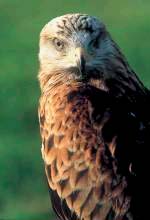
The Kite Country Project was launched as a partnership of County and District councils, the RSPB, CCW, Wales Tourism Board, Development Board for Rural Wales, Mid-Wales Tourism and Forest Enterprise in 1994. It is supported by Objective 5b money, the Welsh Office and private sector sources. The aim is to increase tourism to the region, promote wildlife and the environment, introduce a wider public to the area, and encourage them to stay longer and so spend more in the local economy. The project has set up six visitor centres; promoted public transport, cycling and walking; installed remote video technology and special feeding stations so that the birds can be observed without disturbance; set up interpretation panels; developed community partnerships for green tourism; and promoted a stay-on-a-farm scheme with 130 farms as participants.
The impacts have been substantial. In 1995-96, there were 148 000 visitors to the Kite Country centres. They spent £5.4 million in the mid-Wales economy during these visits, about half of which has been attributed to the presence of the kites. A third of the visits are during winter, formerly a very low season for tourism. People who come tend to stay longer and come back more often. The project has created and/or safeguarded 114 FTE jobs in the local community, and created a further 14 directly through employment of staff and contractors. 1995 was also the best breeding year seen for the Red Kite, with 120 pairs fledging 112 young.
® Source: Rayment (1997)
In 1980, the Sri Lankan government's Irrigation Department, the Agrarian Research Training Institute (ARTI), and the Cornell Rural Development Committee began working with small-holder farmers in the Gal Oya irrigation scheme. At the time, this was the largest and most run-down scheme in Sri Lanka. The approach to rehabilitation was to place young community organizers in the field, who would encourage farmers to form water users' associations, so that they could solve irrigation problems for themselves. The historical context was one of 30 years of conflict and non-cooperation. Asenior official in the Irrigation Department said "if we can make progress in Gal Oya, we can make progress anywhere in Sri Lanka".
The organizers were recruited and trained by ARTI to live and work in the communities, with the primary objective of ensuring that all plans were the farmers own. Water users groups were formed, but not forced on farmers. The organizers, also called animators, promoters or motivators, worked as catalysts to stimulate and nurture local organization. The usual approach to establishing rural organizations (calling a meeting, passing a constitution, and electing officers) was known not to lead to sustainable organizations. Here the approach was to let groups evolve, beginning first with problem identification and collective action, which could lead to formal organization later. The process brought forth more tested and altruistic leadership, who had solid support amongst their members.
The project has rehabilitated 10 000 ha, with benefits exceeding costs by a ratio of 1.5 to 1. The economic benefits of the project depend primarily on increased water use efficiency, which enabled farmers to increase their cropping intensity and thereby raise production. There were also some increases in yields. These changes in the efficiency and equity of water use have been dramatic and long lasting. The number of complaints received by the Irrigation Department about water distribution fell to nearly zero, as adjustments were made by farmers and field-level staff. Before the project, 80 percent of channel gates were broken; afterwards this problem practically disappeared. Farmers' organizations have maintained themselves, progressed institutionally, and developed their own capacity for dealing with problems.
Farmers' organizations, once established, have used their new capabilities to deal with many other needs, such as crop protection, credit supply, settlement of domestic disputes, land consolidation and reducing drunkenness. Bureaucratic reorientation has been essential for success. This has been promoted amongst engineers and officials by demonstrations of farmers' knowledge and ability to achieve unexpected improvements. This iterative process has been crucial: "displays of initiative and intelligence by farmers gained some respect from officials, and this in turn encouraged farmers to show more capability, which again increased the respect accorded them by officials" (Norman Uphoff).
The value of social capital was showed in 1998 during a drought. According to the government, there was only enough water for irrigation of 4 900 ha of rice, but farmers persuaded the Irrigation Department to let the water through and they would carefully irrigate the whole 26 300 ha. Through cooperation and careful management, they achieved a better than average harvest, worth some US$20 million to the country as a whole (Uphoff, 1999).
® Source: Uphoff (1999); Wijayaratna and Uphoff (1997)
The state of New York gives a good example of the relative costs of restoration against the costs of preventing the damage to natural capital in the first place. New York City gets 90 percent of its drinking water from the 512 000 hectare Catskill-Delaware watershed complex, which yields 5.48 billion litres of water per day for its 9 million users. In the late 1980s, the city was faced with having to construct a filtration facility to meet new drinking water standards, the cost of which would be US$58 billion, plus another US$200-500 million in annual operating costs. Estimates at the time indicated that 40 percent of the cropland in the watershed complex would also have to be taken out of farming so as to reduce run-off of eroded soil, pesticides, nutrients and bacterial and protozoan pathogens.
Instead, it decided on a collaborative approach with farmers. It funded a Watershed Agricultural Council, a partnership of farmers, government and private organizations, that sought voluntary upstream solutions to the drinking water problem. The aim was both to protect the city's drinking water supply and to sustain the rural economy. It works on whole farm planning with each farm, tailoring solutions to local conditions to maximize the reduction in off-site or external costs. The initial target was 85 percent of the total 550 farmers; otherwise the city reserved the right to enforce regulations on farmers. The first two phases of the programme leading to the 85 percent target will have cost some US$100 million. This represents a small fraction of the cost of a filtration plant. Not only does the city and its taxpayers benefit, but so do the communities in the watershed and their local natural capital.
® Source: Pretty (1998). The Living Land
Several studies have recently sought to cost the negative externalities of modern agriculture in Germany, Netherlands, United Kingdom and the United States of America, or to illustrate the losses in ecosystem services with the modernization of agriculture in Sweden. The data, however, are not wholly comparable in their original form as different frameworks and methods of assessment have been used. Methodological concerns have also been raised about some studies.
Some have noted that several effects could not be assessed in monetary terms, whilst others have appeared to be more arbitrary (e.g. the US$2 billion cost of bird deaths in the US is arrived at by multiplying 67 million losses by US$30 a bird. Astudy on Netherlands agriculture was even more arbitrary, as it added an estimate the costs farmers would incur to reach stated policy objectives, and these were based on predicted yield reductions of 10-25 percent arising from neither cheap nor preferable technologies, which led to a large overestimate of environmental damage.
Anew framework was recently developed for a University of Essex led study of the United Kingdom agriculture, and is used to present new comparative data on negative externalities in the United Kingdom, United States and Germany (see Table). This uses seven cost categories to assess negative environmental and health costs. Two types of damage cost were estimated for the United Kingdom: i) the treatment or prevention costs (those incurred to clean up the environment and restore human health to comply with legislation or to return these to an undamaged state); and ii) the administration and monitoring costs (those incurred by public authorities and agencies for monitoring environmental, food and health parameters). Only those externalities which gave rise to financial costs were estimated.
This framework includes only external costs, i.e. the costs passed on to the rest of society through the actions of farmers. Additional private costs borne by farmers themselves are not included, such as from increased pest or weed resistance from the overuse of pesticides, or for training in the use, storage and disposal of pesticides. However, there remain unmeasured distributional problems: for example insect outbreaks arising from pesticide overuse can affect all farmers, even those not using pesticides.
Even though the research to date still contains many gaps where costs have yet to be calculated, these studies suggest that the external costs of modern agriculture in 1996 amounted to £49-71 (US$81-117) per hectare of arable and grassland in Germany and the United States, but rising to £208 (US$343) in the United Kingdom. These differences, however, may not be significant, owing to large gaps and uncertainties in the data (without the cost of BSE, for example, the per hectare costs in the United Kingdom come down to £154/ha). It appears that costs per hectare of arable are higher than for livestock; and the external costs associated only with pesticides amount to £2.2-8.6 (US$3.7-14.2) per kg active ingredient used. These are substantial burdens on non-agricultural sectors of economies.
For a variety of reasons, these estimates are likely to be conservative:
® some costs are known to be substantial underestimates (e.g. acute and chronic pesticide poisoning of humans; monitoring costs; eutrophication of reservoirs; restoration of all hedgerow losses);
® some currently cannot be calculated (e.g. dredging to maintain navigable water; flood defenses; marine eutrophication; poisoning of domestic pets);
® the costs of returning the environment or human health to pristine conditions were not calculated;
® treatment and prevention costs may be underestimates of how much people might be willing to pay to see positive externalities created;
® the data do not account for time lags between the cause of a problem and its expression as a cost (i.e. some processes long since stopped may still be causing costs; some current practices may not yet have caused costs);
® this study did not include the externalities arising from transporting food from farms to manufacturers, processors, retailers and finally to consumers.
|
The annual external costs of modern agriculture in United Kingdom, United States of America and Germany ($ million, adjusted to 1996 prices) |
||||
|
Cost Category |
United Kingdom |
United States of America |
Germany |
|
|
1. Damage to Natural Capital: Water |
|
|
|
|
| |
Pesticides in sources of drinking water |
187 |
921 |
90 |
| |
Nitrate, phosphate and soil in sources of drinking water |
110 |
1 267 |
+ |
| |
Zoonoses (esp. Cryptosporidium) in sources of drinking water |
36 |
+ |
+ |
| |
Eutrophication, pollution incidents, fish deaths, monitoring costs |
26 |
265 |
51 |
|
2. Damage to Natural Capital: Air |
|
|
|
|
| |
Emissions of methane, ammonia, nitrous oxide and carbon dioxide |
1 733 |
17 028 |
1 752 |
|
3. Damage to Natural Capital: Soil |
|
|
|
|
| |
Off-site damage caused by erosion |
22 |
|
+ |
| |
flooding, blocked ditches and lost water storage |
|
3 561 |
|
| |
damage to industry, navigation and fisheries |
|
8 978 |
|
| |
Organic matter and carbon dioxide losses from soils |
128 |
+ |
+ |
|
4. Damage to Natural Capital: Biodiversity and Landscape |
|
|
|
|
| |
Biodiversity/wildlife losses |
39 |
340 |
6 |
| |
Hedgerows and drystone wall losses |
154 |
+ |
+ |
| |
Bee colony losses and damage to domestic pets |
3 |
237 |
2 |
|
5. Damage to Human Health: Pesticides |
12 |
137 |
14 |
|
|
6. Damage to Human Health: Nitrate |
0 |
+ |
+ |
|
|
7. Damage to Human Health: Microorganisms / Disease Agents |
|
|
|
|
| |
Bacterial and viral outbreaks in food |
263 |
+ |
+ |
| |
BSE and new variant CJD |
946 |
+ |
+ |
| |
Overuse of antibiotics |
+ |
+ |
+ |
|
Total annual external costs |
3 650 |
32 762 |
1 917 |
|
|
Total costs per hectare of arable and grassland |
324 |
76 |
111 |
|
|
Costs per hectare of arable only |
355 |
106 |
259 |
|
|
Costs per kg of pesticide active ingredient |
13.4 |
3.4 |
6.1 |
|
|
+ = cost estimates not yet calculated (or available). |
||||
® Source:
Pretty et al. (2001).Policy challenges and priorities for internalizing
the externalities of modern agriculture.
Journal of Environmental Planning and Management 44 (2), 263-283
Agricultural systems contribute to carbon emissions through:
® the direct use of fossil fuels in farm operations;
® the indirect use of embodied energy in inputs that are energy-intensive to manufacture;
® the cultivation of soils resulting in the loss of organic matter.
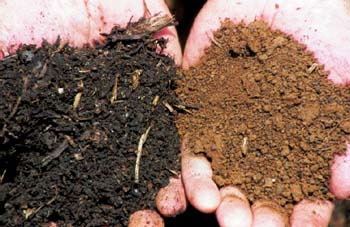
On the other hand, farming offsets such losses when it accumulates organic matter in the soil, or when above-ground woody biomass acts either as a permanent sink or is used as an energy source that substitutes for fossil fuel. Options for reducing carbon emissions from farms include conservation of fuel and reduced energy use; conservation tillage to reduce CO2 emissions from soils; grass-based grazing systems to reduce methane emissions; composting to reduce manure methane production; substitute fossil fuels by biofuels; adopt low machinery-use; reduce use of inorganic fertilizers; and targeted and slow release fertilizers. Options for increasing carbon sinks on farms include conservation and no-tillage; mixed rotations using cover crops and green manures; minimize summer fallows; apply composts and manures; improve pasture and rangelands through grazing and vegetation management; use perennial rather than annual grasses, as perennials have 60-80 percent of biomass below ground compared with 20 percent for annuals; restoring and protecting wetlands (provided C-sequestration is greater than methane production); converting agricultural land to woodlands; adopt agroforestry; and cultivate crops for biofuels (grasses, coppiced trees).
Zero- or No-Till is a farming system are left on the field as protection against soil erosion. At planting, the seed (and fertilizer, if required) is slotted into a groove cut into the surface of the soil. Weeds are often, but not always, controlled with herbicides. This means that the soil surface is always covered, and the soil itself never inverted. Farmers use a range of IPM, rotational and precision methods for pest and nutrient management. For example, black oats are now commonly used in the rotation during winter for both soil cover and weed suppression. Other legume cover crops are used to improve nitrogen supplies. In Argentina, ZT was first tested by farmers in the late 1980s, and by 1990, there were about 100 000 ha of ZT. The 1990s, however, saw remarkable growth in the technology rising to some 7.3 million hectares in 1999, and covering 30 percent of all Argentinean arable land. ZT has also spread rapidly in Paraguay and southern Brazil over the same period. There are several reasons for this rapid spread:
® significant private benefits for farmers yields of maize have grown 37 percent from 2 to 3.54 t/ha with ZT, and soya 11 percent to 2.47 t/ha. Costs have fallen through reduced energy use, more efficient use of inputs, reduced demand for labour (from US$50-70 to US$30 per ha), and improved farm assets through increased organic matter content in soils, better pest control and improved water retention;
® significant public environmental benefits, through reduced soil erosion and water pollution (of pesticides and nitrate), and increased carbon sequestration in soils;
® direct support and promotion by farmers organizations themselves, in particular AAPRESID (Argentinean No Till farmers organization) - as Roberto Peiretti puts it: "the adoption of NT in Argentinean and neighbouring countries was a farmer-led movement... [and] attributed to the common sense of farmers and their ability to detect new economic, physical and other advantages of the system". Local ZT farmer research and extension groups have been formed, and these linked to regional and national groups. Such coalitions of farmers have been critical in the continued development, adaptation and spread of ZT technology.
® Source:
Roberto Peiretti (Member of the Board of Directors and Technical Committees
of AAPRESID
(No-Till Farmers Argentinean Association) and member of the Steering Committee
of CAAPAS
(American Confederation of Sustainable Agriculture Farmers Association) <[email protected]>
